Horticulture :: Vegetables:: Brinjal
|
||||||||||||||||||||||||||||||||||||||||||||||||||||||||||||||||||||||||||||||||||||||||||||||||||||||||||||||||||||||||||||||||||||||||||||||||||||||||||||||||||||
Brinjal
Solanum melongena L. Solanaceae
Varieties
Co 1, Co 2, MDU 1, PKM 1, PLR 1,PLR (B) 2, KKM 1, PPI 1, Annamalai COBH 1 and COBH 2 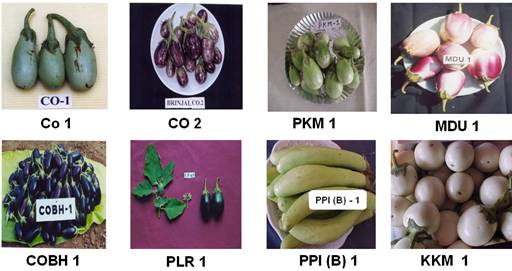
Soil
Well drained soil rich in organic matter with pH of 6.5-7.5.
Season of Sowing
December – January and May – June.
Nursery bed preparation
Apply FYM 10 kg, neem cake 1 kg, VAM 50 g, enriched super phosphate 100 g and furadon 10 g per square metre before sowing. Area required for raising seedling for planting 1.0 ha is 100 sq.m.
Seed rate
Varieties : 400 g / ha Hybrids : 200 g / ha
Seed treatment
Treat the seeds with Trichoderma viride @ 4 g / kg or Pseudomonas fluorescens @ 10 g / kg of seed. Treat the seeds with Azospirillum @ 40 g / 400 g of seeds using rice gruel as adhesive. Irrigate with rose can. In raised nursery beds, sow the seeds in lines at 10 cm apart and cover with sand. Transplant the seedlings 30 – 35 days after sowing at 60 cm apart in the ridges.
Protected nursery
Field preparation
Thoroughly prepare the field with the addition of FYM @ 25 t / ha and form ridges and furrows at a spacing of 60 cm. Apply 2 kg / ha of Azospirillum and 2 kg / ha of Phosphobacteria by mixing with 50 kg of FYM. Irrigate the furrows and transplant 30-35 days old seedlings at 60 cm apart on the ridges.
Spacing
Varieties : 60 x 60 cm Hybrids : 90 x 60 cm
Mulching
Mulch with black LDPE sheets of 25 micron thickness and bury both the ends into the soil to a depth of 10 cm.
Weed control
Apply Pendimethalin 1.0 kg a.i. / ha or Fluchloralin 1.0 kg a.i / ha as pre-emergence herbicide, followed by hand weeding once at 30 days after planting.
Irrigation
After establishment of seedlings, irrigate at weekly intervals.
Layout and planting for drip irrigation and fertigation
Manuring
Apply 2 kg each of Azospirillum and Phosphobacteria in the main field at planting.
Varieties
Basal dose : FYM 25 t/ha, NPK 50:50:30 kg/ ha. Top dressing : 50 kg N/ha on 30th day of planting or during earthing up.
Hybrids
Basal dose : FYM 25 t/ha, NPK 100:150:100 kg/ha. Top dressing : 100 kg N/ha on 30th day of planting or during earthing up.
Fertigation schedule for hybrids
Recommended dose: 200:150: 100 kg / ha
75% RD of Phosphorus applied as superphosphate = 703 kg / ha.
1. 19:19:19 = 79 kg / ha 2. 13:0:45 = 189 kg/ ha 3. 12:61:0 = 37 kg / ha 4. Urea = 340 kg / ha
Growth regulators
Spray 2 ppm (1 ml in 500 lit) Triacontanol plus Sodium Borate or Borax 35 mg/l of water 15 days after transplanting and at the time of full bloom to increase the yield.
After cultivation
Hand weeding, top dressing and earthing up on 30th day of planting.
Plant protection
Pests Shoot & fruit borer
Nematode and Damping off disease
Seed treatment with antagonistic fungi viz. Trichoderma harzianum 4 g/kg seed and T. viride 4 g/kg seed along with application of press mud at 5 kg/m2 or Carbofuran 3 G 10 g/m2. Application of Carbofuran 3 G at 10 g/sq.m at the time of sowing. Apply Pseudomonas fluorescens at 10 g/m2 at the time of sowing to control root knot nematode and damping off disease.
Epilachna beetle
Whitefly
Monitor the whitefly with yellow sticky trap at 12 Nos./ha. Spray Neem oil 3% + Teepol (1 ml/lit) or spray Neem Seed Kernel Extract 5 %.
Ash Weevil
Apply Carbofuran 3 G at 15 kg/ha at 15 days after planting. 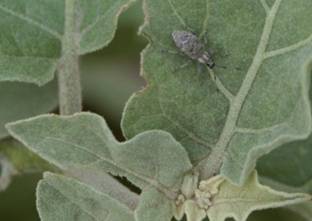 Ash weevil
Aphid
Release 1st instar larvae of Green lace wing bug (Chrysoperla carnea) @ 10,000 Nos./ha. Apply phorate 10 % G @ 15 kg /ha or spray any one of the following insecticide
Red Spider mite
Apply phorate 10 % G @15 kg /ha or spray any one of the following insecticide
Diseases
Damping off Treat the seeds with Trichoderma viride 4 g/kg or Pseudomonas fluorescens 10 g /kg of seed 24 hours before sowing. Apply Pseudomonas fluorescens as soil application @ 2.5 kg/ha mixed with 50 kg of FYM. Water stagnation should be avoided. Drench with Copper oxychloride at 2.5 g/lit at 4 lit/sq.m
Leaf Spot
Leaf spot can be controlled by spraying Mancozeb 2 g/lit.
Little Leaf
Remove the affected plants in the early stages and spray Methyl demeton 30 EC @ 1.0 ml/lit. to control the vector. 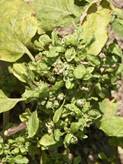 Little leaf
Harvest
Harvest can be done 55 – 60 days after transplanting. Fruits are harvested at tender stage at 4 – 5 days intervals.
Yield
Varieties:25 to 30 t/ha Hybrids:60 - 80 t/ha
Market information
IPM Package for Brinjal
Source
1. http://susveg-asia.nri.org/susvegasiabrinjalipm4.html 2. http://susveg-asia.nri.org/images/svcorkipmb5.JPG 3. http://susveg-asia.nri.org/images/svcorkipmb18.JPG 4. http://susveg-asia.nri.org/images/svcorkipmb16.JPG | ||||||||||||||||||||||||||||||||||||||||||||||||||||||||||||||||||||||||||||||||||||||||||||||||||||||||||||||||||||||||||||||||||||||||||||||||||||||||||||||||||||
Agriculture Information, Agriculture News, Agriculture jobs in India
Sunday, 9 March 2014
Horticulture :: Vegetables:: Brinjal
Subscribe to:
Post Comments (Atom)
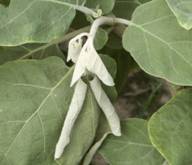
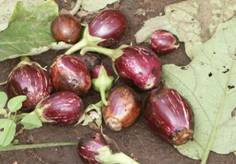
The PP Leno Bags are one of the most effective and flexible packaging solutions for storage and transportation of agricultural and industrial products in the constantly evolving packaging industry. PP Leno Mesh Bags are widely produced using polypropylene to manufacture these mesh bag products which are flexible, lightweight, durable and breathable.
ReplyDelete